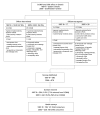Motivations for consulting complementary and alternative medicine practitioners: a comparison of consumers from 1997-8 and 2005
- PMID: 18442414
- PMCID: PMC2390516
- DOI: 10.1186/1472-6882-8-16
Motivations for consulting complementary and alternative medicine practitioners: a comparison of consumers from 1997-8 and 2005
Abstract
Background: Use of complementary and alternative medicine (CAM), and especially CAM practitioners, has continued to rise in recent years. Although several motivators of CAM use have been identified, little is known about how and if the motivations for using CAM have changed over time. The purpose of the current study was to compare the reasons for consulting CAM practitioners in consumers in 1997-8 and eight years later in 2005.
Methods: Surveys were displayed in CAM and conventional medicine offices and clinics in Ontario, Canada in 1997-8 and again in 2005, and self-selected participants returned the surveys by mail.
Results: In 1997-8, 141 CAM consumers were identified from the 199 surveys returned, and 185 CAM consumers were identified from the 239 surveys returned in 2005. Five of the six CAM motivations were more likely to be endorsed by the 2005 CAM consumers compared to the 1997-8 CAM consumers (all p's < .0001). In 1997-8 the two top reasons for using CAM were that CAM allowed them to take an active role in their health (51.8%), and because conventional medicine was ineffective for their health problem (41.8%). In 2005, the treatment of the whole person (78.3%) was the top reason for using CAM followed by taking an active role in one's health (76.5%). The 2005 consumers were less educated, had slightly more chronic health complaints, had been using CAM for longer, and were more likely to consult chiropractors, reflexologists, and therapeutic touch practitioners than the 1997-8 consumers. Otherwise, the socio-demographic and health profiles of the two groups of CAM consumers were similar, as was their use of CAM.
Conclusion: Compared to consumers in 1997-8, consumers in 2005 were more likely to endorse five of the six motivations for consulting CAM practitioners. A shift towards motivations focusing more on the positive aspects of CAM and less on the negative aspects of conventional medicine was also noted for the 2005 consumers. Findings suggest that CAM motivations may shift over time as public knowledge of and experience with CAM also changes.
Figures


Similar articles
-
Personality and consultations with complementary and alternative medicine practitioners: a five-factor model investigation of the degree of use and motives.J Altern Complement Med. 2008 Nov;14(9):1151-8. doi: 10.1089/acm.2007.0801. J Altern Complement Med. 2008. PMID: 18991517
-
Trends in use of complementary and alternative medicine by US adults: 1997-2002.Altern Ther Health Med. 2005 Jan-Feb;11(1):42-9. Altern Ther Health Med. 2005. PMID: 15712765
-
Use of complementary and alternative therapies in community-dwelling older adults.J Altern Complement Med. 2007 Nov;13(9):997-1006. doi: 10.1089/acm.2007.0527. J Altern Complement Med. 2007. PMID: 18047447
-
Comparison of complementary and alternative medicine use: reasons and motivations between two tertiary children's hospitals.Arch Dis Child. 2006 Feb;91(2):153-8. doi: 10.1136/adc.2005.074872. Epub 2005 Sep 15. Arch Dis Child. 2006. PMID: 16166178 Free PMC article.
-
Potential factors that influence usage of complementary and alternative medicine worldwide: a systematic review.BMC Complement Med Ther. 2020 Nov 23;20(1):363. doi: 10.1186/s12906-020-03157-2. BMC Complement Med Ther. 2020. PMID: 33228697 Free PMC article.
Cited by
-
Consultation clinics for complementary and alternative medicine at Japanese university hospitals: An analysis at Tokushima University Hospital.Exp Ther Med. 2010 May;1(3):481-483. doi: 10.3892/etm_00000075. Epub 2010 May 1. Exp Ther Med. 2010. PMID: 22993564 Free PMC article.
-
Asthma patients' perception on their care pathway: a qualitative study.NPJ Prim Care Respir Med. 2019 Apr 2;29(1):9. doi: 10.1038/s41533-019-0121-2. NPJ Prim Care Respir Med. 2019. PMID: 30940806 Free PMC article.
-
Determinants of public trust in complementary and alternative medicine.BMC Public Health. 2010 Mar 12;10:128. doi: 10.1186/1471-2458-10-128. BMC Public Health. 2010. PMID: 20226015 Free PMC article.
-
A dual continuum model of the reasons for use of complementary health approaches among overweight and obese adults: findings from the 2012 NHIS.BMC Complement Altern Med. 2018 Dec 20;18(1):339. doi: 10.1186/s12906-018-2404-5. BMC Complement Altern Med. 2018. PMID: 30572881 Free PMC article.
-
Why people use herbal medicine: insights from a focus-group study in Germany.BMC Complement Altern Med. 2018 Mar 15;18(1):92. doi: 10.1186/s12906-018-2160-6. BMC Complement Altern Med. 2018. PMID: 29544493 Free PMC article.
References
-
- Park J. Use of alternative health care. Health Rep. 2004;16
-
- Esmail N. Complementary and alternative medicine in Canada: Trends in use and public attitudes, 1997-2006. Public Policy Sources. 2007;87:1–53.
-
- Barnes PM, Powell-Griner E, McFann K, Nahin RL. Complementary and alternative medicine use among adults: United States, 2002. Adv Data. 2004;343:1–19. - PubMed
-
- Robinson A, Chesters J, Cooper S. People’s choice: Complementary and alternative medicine modalities. Compl Health Pract Rev. 2007;12:99–119. doi: 10.1177/1533210107302436. - DOI
Publication types
MeSH terms
LinkOut - more resources
Full Text Sources
Medical

